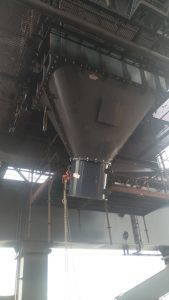At a major UK ship unloading terminal, operators faced ongoing challenges in maintaining material flow during the offloading of dry bulk cargos. Frequent blockages in transfer chutes, particularly when handling wet coal, resulted in costly downtime and the risk of incurring demurrage penalties.
To address this, Kingfisher Industrial (KI) was commissioned to design, manufacture, and install a bespoke, wear-protected chute system that would enhance reliability, efficiency, and safety throughout the unloading process.
Background
Dry bulk terminals play a crucial role in transporting essential raw materials, such as coal, coke, iron ore, biomass, grain and aggregates, from ships to shore. At this site, material is unloaded from a bulk carrier using shore-based cranes and clamshell grabs, then transferred through large hoppers into an apron feeder. The feeder regulates flow into a chute, which discharges onto a belt conveyor system for further transport and stockpiling.
The operation handles thousands of tonnes per day, so even minor interruptions have significant financial and logistical impacts. The new feeder, designed to increase throughput, extended the discharge point beyond the centreline of the conveyor. This shift required a complete redesign of the chute geometry to realign the material flow and ensure even loading onto the belt.
BEFORE
The Challenge
The longer feeder meant the material discharge point no longer matched the conveyor belt’s centre. The misalignment risked uneven loading, belt tracking issues, and material spillage. Engineers also had to accommodate the varying behaviour of different cargos, from various types of iron ore, coke, to moisture-laden coal. Despite initial best-practice designs, the first iteration of the chute experienced blockages during wet coal handling, which restricted throughput and required manual intervention.
Downtime during unloading operations also risked demurrage costs for the terminal – a penalty applied when ships are delayed in port beyond the agreed unloading time.
The Kingfisher Solution
Kingfisher delivered a full turnkey package: design, manufacture, protective lining, mechanical installation, and commissioning. The engineering team conducted an in-depth site survey, analysing flow characteristics and chute geometry. Using 3D modelling and flow simulation, KI developed a revised chute design featuring radial corner gullies and a straight cylindrical section to promote mass flow and eliminate dead zones.
To withstand the abrasive and cohesive nature of the various types of materials handled, the internal surfaces were lined with Kingfisher’s wear-resistant systems, incorporating the K-ALOX ceramic lining system in high-impact wear points and the K-PLAS low-friction lining system in areas subject to material buildup, where smooth discharge was critical. This combination ensured both longevity and improved flow.
The top section of the chute has been completely redesigned to improve material flow. Previously, it transitioned from square to square through a tapered section, which restricted discharge and created build-up points. The new design changes this to a square-to-round transition, leading into a straight cylindrical tube, which allows for a smoother and more consistent flow. The top chute now also features a central flange. This means that when wear occurs on one side, only that section needs to be replaced, reducing maintenance time and cost.
Installation took place during a planned maintenance window and required precise mechanical handling. Due to limited structural support on the ship unloader, the chute and feeder assembly had to be suspended from the feeder and positioned centrally to the belt, then installed by Kingfisher’s in-house mechanical team. The installation showcased Kingfisher Industrial’s ability to deliver complex mechanical work safely and efficiently within tight operational constraints.
AFTER
The Kingfisher Industrial Turnkey Solution – Revised Chute Design -Top Section: square-to-round transition featuring radial corner gullies leading into a straight cylindrical section:
This project highlights how design-led engineering can prevent costly interruptions in dry bulk operations. Accurate modelling of flow paths, combined with the correct lining materials, can significantly improve throughput and reduce operator risk. Integrating wear protection into the mechanical design stage ensures both performance and reliability under challenging material conditions.
Technical Summary
| Industry | Dry Bulk Cargo Handling |
| Location | UK Ship Unloading Terminal |
| Equipment Protected | Transfer chute from apron feeder to conveyor |
| Lining System | K-ALOX (ceramic) + K-PLAS (low-friction) |
| Material Type | coal, coke, iron ore, biomass, grain and aggregates |
| Installation | On-site during planned shutdown |
| Service Life Improvement | 3x increase |
| Completion Date | September 2025 |
Book a site survey or consultation with Kingfisher’s engineering team on 01562 543108 or email enquiries@kingfisher-industrial.com to review your unloading, chute and hopper systems, and plan any upgrades ahead of your next maintenance window.
Kingfisher Industrial specialises in maximising the service performance of process plant and equipment, such as transfer chutes, cyclones, hoppers, vessels, and process pipework used to convey, store or process bulk solid materials within utilities, primary manufacturing and process industries. In negating the detrimental effects of materials such as aggregates, recycled products, cement and imported bulk cargo, we add significant value to your assets, ensuring your process remains operational.
Our service includes the design, manufacture, and installation of wear-resistant lining systems across global markets in multiple industry sectors.





